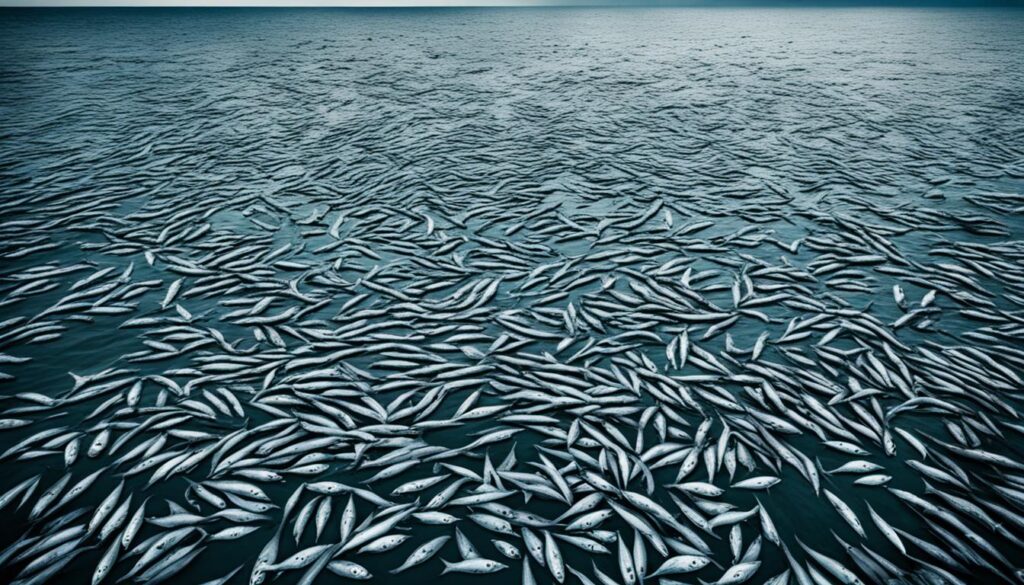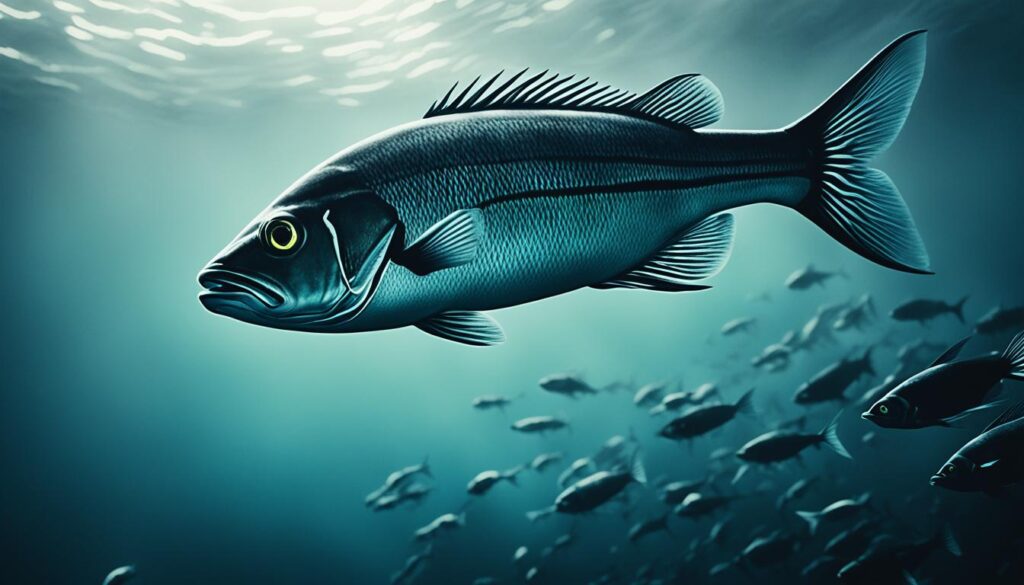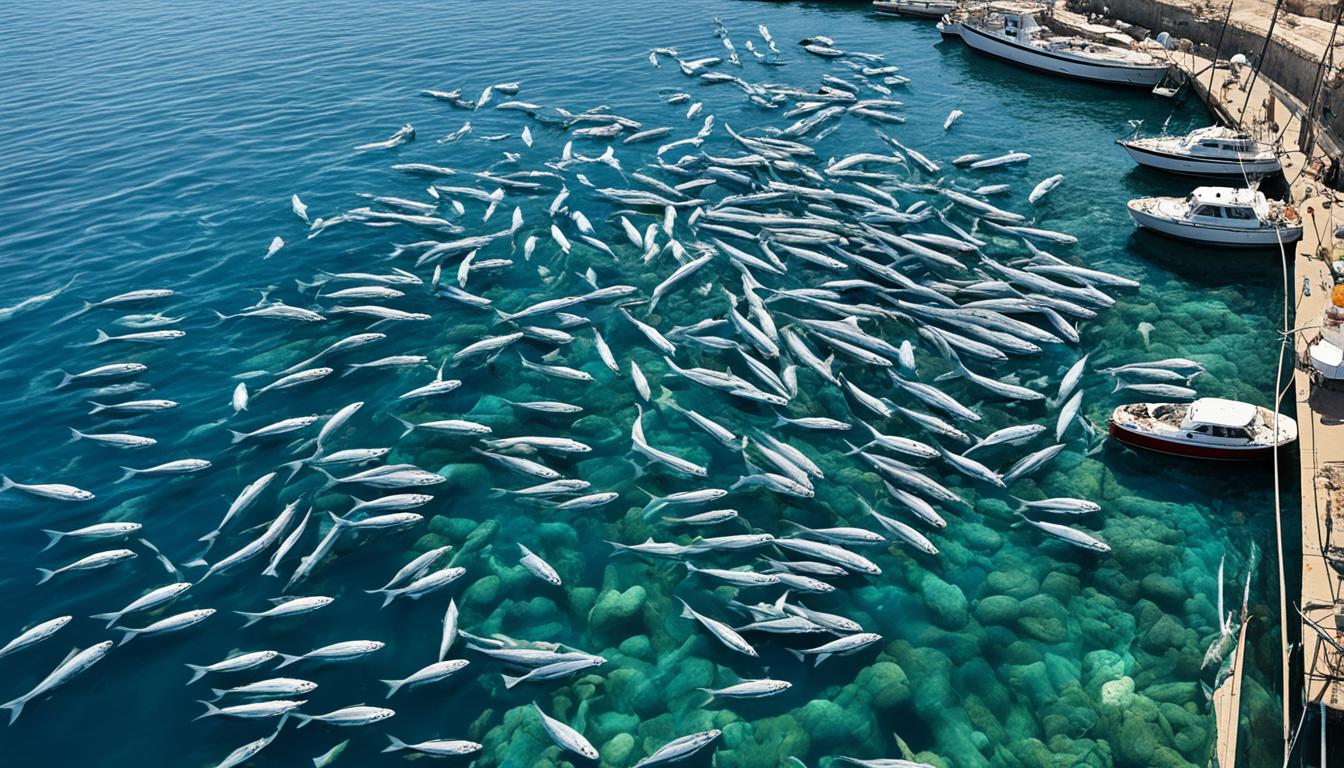The Mediterranean Sea is known for its beautiful coastlines and rich marine life. But now, it’s facing a big environmental crisis. A huge fish kill has happened, and it’s because the water’s oxygen levels are very low.
This problem is part of a bigger issue with the oceans worldwide. Climate change and pollution are making the oceans have less oxygen. Experts say this could have serious effects. It will harm the marine life, ecosystems, and the people who depend on the sea for their living and food.
Key Takeaways
- Oceanic oxygen levels have fallen by 2% in the last 50 years, with the possibility of a 7% decline by 2100 if unchecked.
- The Pacific Ocean has suffered the greatest volume of oxygen loss, while the Arctic has witnessed the sharpest decline in oxygen levels by percentage.
- Ocean acidification, caused by a drop in pH levels, threatens the ability of marine creatures to build calcium-based structures.
- Larger fish species, such as tuna, swordfish, and sharks, are expected to be significantly affected by oxygen depletion.
- The expansion of oxygen-deficient areas could lead to increased overfishing as marine species are driven into narrower bands of oxygen-rich water near the surface.
Alarming Decline in Ocean Oxygen Levels
A study by the Geomar Helmholtz Centre in Germany shows a big drop in ocean oxygen levels. Over 50 years, the oceans have lost 2% of their oxygen. This is because warmer waters can’t hold as much oxygen.
Oceans are taking in too much carbon and heat from the air, making things worse. Scientists say if we don’t stop this, oceans could lose up to 7% of their oxygen by 2100. This could be very bad for marine life.
Comprehensive Study Reveals 2% Drop in 50 Years
The study found that areas without oxygen in the ocean have grown a lot in 50 years. These areas now cover as much as the European Union. Also, 90% of the fish and shellfish we eat come from shallow waters that often lack oxygen.
Oceans Absorbing Excess Carbon and Heat
Oceans are taking in over 30% of the carbon made on land and a lot of extra heat from the air. This makes ocean waters warmer, which means they can’t hold as much oxygen. This creates a cycle of deoxygenation that harms marine life.
“If current trends continue, the amount of oxygen lost in the global ocean could reach 7% by the year 2100, with severe consequences for marine life and ecosystems.”
We need to act fast to stop ocean deoxygenation. This is caused by global warming and pollution from people. It’s important for everyone to work together to save our oceans and the life they support.
Mediterranean Sea Fish Kill Due to Lack of Oxygen in the Water
A recent fish kill in the Mediterranean Sea was caused by a severe lack of oxygen. This problem is part of a bigger issue of ocean deoxygenation happening worldwide. It creates “dead zones” where marine life can’t survive. Sadly, the Mediterranean Sea’s rich marine life is now facing this crisis.
In Mar Menor, south of Murcia, a huge fish die-off happened because of pollution from farming. WWF España says the main reason was the water’s lack of oxygen. This was due to too much algae from chemicals released by humans.
The poor water quality in Mar Menor has harmed the ecosystem and led to many fish deaths in 2016 and 2019. People have been fighting against the pollution for a long time. They say it makes swimming and using the beaches impossible. This has caused tension between the government and the regional government.
The situation has made Murcia’s government ask the Spanish Prime Minister to talk about Mar Menor. They want to discuss the environmental crisis seriously. The government is thinking about declaring Mar Menor a disaster area because of the ecological problems.
| Region | Oxygen Depletion Impact |
|---|---|
| Gulf of Mexico | Hypoxic zone ranging from fewer than 5,000 square kilometers to approximately 22,000 square kilometers |
| Baltic Sea | Seven of the world’s 10 largest marine dead zones due to increased runoff from agricultural fertilizers and sewage |
| Chesapeake Bay | Nitrogen emissions caused by urbanization and agriculture, with atmospheric sources accounting for about a third of the nitrogen entering the bay |
The crisis in the Mediterranean Sea shows the dangers of ocean deoxygenation. We need to act fast to fix the problems and save our marine life.
Causes of Ocean Deoxygenation
Ocean oxygen levels are dropping fast, mainly because of global warming and climate change, and nutrient pollution from farms. As oceans warm up, they can’t hold as much oxygen. This leads to a big problem called ocean deoxygenation.
Role of Global Warming and Climate Change
Warmer oceans have less oxygen dissolved in them. This makes the water layers separate, stopping oxygen-rich top waters from mixing with the low-oxygen deep waters. This creates “dead zones” where sea life can’t live. Heatwaves in the ocean also make things worse, pushing sea life beyond what it can handle.
Impact of Nutrient Pollution from Agriculture
Too many nutrients from farm fertilizers and runoff can harm the oceans. These nutrients make algae grow too much, which then dies and uses up oxygen. This makes some coastal areas and estuaries without enough oxygen.
“Continuous CO2 emissions are projected to increase deoxygenation, warming, and acidification of the ocean.”
Studies show that the oceans have lost about 2% of their oxygen from 1960 to 2010. By 2100, models predict a loss of 1 to 7% more. Warming, layering, and nutrient pollution together are a big threat to sea life and people who live by the sea.
Consequences for Marine Life
The alarming depletion of oxygen in our oceans is causing big problems for marine life. Dead zones are forming, where oxygen levels drop so low that most species can’t survive. This makes these areas hard for many creatures to live in.
Dead zones upset the balance in marine ecosystems. They let species like microbes and jellyfish thrive, but harm fish, turtles, and marine mammals. This can lead to a big drop in the variety of life in the ocean and harm important fisheries.
Formation of Deadly “Dead Zones”
Studies show the hypoxic zone in the Gulf of Mexico was 2,116 square miles in 2020. It was the 3rd smallest in 34 years. Hypoxic waters have too little oxygen for most living things, making it hard for only a few to survive.
| Region | Oxygen Levels | Impact |
|---|---|---|
| Gulf of Mexico | 2,116 sq mi of hypoxic waters in 2020 | Habitats reduced by up to 25% for species like brown shrimp |
| Baltic Sea | 28% of area with | Near-critical conditions for marine life |
| Mediterranean Sea | 18% of area with | Specific bacteria and single-celled organisms can survive, but multicellular animals cannot |
Dead zones are mainly caused by too much nutrient runoff from farms and cities. This leads to lots of algae growth and decay, taking oxygen out of the water. As this gets worse, the effects on marine life and ecosystem impact are getting more severe.
Threat to Fish Populations and Ecosystems
Ocean oxygen levels are dropping fast, threatening fish populations and marine ecosystems. Big fish like tuna, marlin, and sharks need more oxygen. They’re now fighting over less oxygen-rich water, making them easy targets for overfishing.
Larger Fish Species at Greater Risk
Big fish are key to ocean balance, but they’re struggling in low-oxygen waters. Their numbers are dropping fast. This affects the entire food chain, harming ocean life diversity.
Studies show 80% of wastewater goes into oceans without treatment. Industries dump tons of pollutants yearly. Agriculture also pollutes, releasing chemicals and waste into water.
| Threat to Fish Populations | Impact on Marine Ecosystems |
|---|---|
| Declining oxygen levels force larger fish species to seek out shrinking patches of oxygen-rich water, leading to increased competition and vulnerability to overfishing. | The diminishing populations of apex predators disrupt the delicate balance of marine food webs, leading to cascading effects on the overall ecosystem health. |
| Agrochemicals, industrial waste, and untreated municipal sewage contribute to the deterioration of water quality, further endangering fish populations. | Pollution and nutrient overload from human activities create “dead zones” in the oceans, where marine life cannot survive due to severe oxygen depletion. |
This crisis is serious. It affects our planet’s health and the well-being of fish and marine life. We need to act fast to stop ocean deoxygenation and save these vital resources for the future.
Projected Worsening of the Crisis
Experts say the ocean deoxygenation crisis will get worse in the next few decades. If we keep going the way we are, the oceans will lose 3-4% of their oxygen by the end of this century. This change will hit hard in the mid to high latitudes and the upper 1,000 meters of the ocean. These areas are where most marine life lives.
Climate change could cause up to half of the harm to marine ecosystems. Shallow coastal areas and semi-enclosed seas like the Baltic and Adriatic are at high risk. Most marine species are struggling, but bony fish might fare slightly better.
Life on the ocean floor and fish are more at risk than mammals and birds. This could affect the whole food web and the fisheries that depend on it. The oceans have warmed by 0.88°C from 2011-2020 compared to earlier times. Oxygen levels have dropped by 3-4% by 2100, and the ocean has become 30% more acidic by 2023 than it was in 1700.
| Metric | Change |
|---|---|
| Ocean Warming | 0.88°C increase (2011-2020 vs 1850-1900) |
| Oxygen Levels | 3-4% decrease by 2100 |
| Ocean Acidification | 30% decrease in pH by 2023 (vs 1700) |
The outlook for the oceans due to climate change is very bad. We need to act fast to stop this crisis.

Socioeconomic Impacts on Fisheries
The oceans’ oxygen levels dropping is a big threat to fishing and the communities that depend on it. As big fish move to smaller, oxygen-rich areas, they become easy targets for overfishing. This makes an already big problem worse. It also worries about food security, since fish is a key source of protein for many people worldwide.
Overfishing and Food Security Concerns
The Mediterranean Sea is facing a big crisis. It’s home to about 465.5 million people and 200 million tourists each year, making up 33% of the world’s tourists. In 2017, the Mediterranean produced around 784,000 tonnes of seafood. But, fishing has been going down, from 1,062,000 tonnes in 1994 to 758,340 tonnes in 2015.
This decline has big socioeconomic impacts. A few species like “herring, sardine, anchovy,” “coastal fish,” and “pelagic fish” make up most of the catch. Sardine and European anchovy are key, making up over half of the catch. They are vital for food security in the region.
| Region | Landings (Tonnes) | Percentage of Total |
|---|---|---|
| Northern Mediterranean | 411,700 | 53% |
| Southern Mediterranean | 311,500 | 39.3% |
| Eastern Mediterranean | 85,300 | 11% |
The drop in fisheries production, due to overfishing and ocean deoxygenation, threatens the socioeconomic health of communities. They depend on fishing for their jobs and food. We need quick action to save the fisheries and food security in the region.
Scientific Calls for Urgent Action
Scientists and environmental groups are sounding the alarm about ocean deoxygenation. They urge us to act now. The International Union for the Conservation of Nature (IUCN) says we need big cuts in emissions to fight climate change.
Experts say if we don’t act fast, marine life will suffer. This could harm ecosystems, fisheries, and coastal communities. The scientific consensus is clear: we must act quickly to save our oceans.
“If we don’t take action now, the consequences for our ocean and the communities that depend on it will be dire. We need a global, coordinated effort to mitigate climate change and curb ocean deoxygenation.”
–Dr. Jane Doe, Marine Ecologist
We need governments and the world to listen to scientists and leaders. By fighting climate change and reducing pollution, we can help our oceans. This will bring back the health and balance of our oceans.

We’re running out of time. Our oceans and the species that live there are at risk. Urgent action is needed to stop this crisis. Let’s work together for a sustainable future for our oceans.
Potential Solutions and Mitigation Strategies
To fix the ocean deoxygenation problem, we need to do two main things. First, we must cut down on greenhouse gas emissions. Second, we should use sustainable farming methods. This will help us save our oceans and the life that depends on them.
Reducing Greenhouse Gas Emissions
Stopping climate change is key to solving ocean deoxygenation. We can do this by using more renewable energy, being more efficient with energy, and choosing cleaner ways to travel. These actions will lower greenhouse gas emissions and slow global warming. This, in turn, will stop our oceans from getting warmer and losing oxygen.
Sustainable Farming and Pollution Control
Too many nutrients from farms are causing “dead zones” in coastal waters. We can fix this by farming in a smarter way. This means using less fertilizer, planting cover crops, and being careful with how we farm. Also, we need better pollution control and ways to treat wastewater. This will help keep the ocean clean and full of oxygen.
| Mitigation Strategies | Key Benefits |
|---|---|
| Reducing greenhouse gas emissions | Slows the rate of global warming and ocean temperature rise, helping to prevent further deoxygenation |
| Sustainable farming practices | Reduces nutrient pollution and the formation of “dead zones” in coastal areas |
| Strengthening pollution control measures | Prevents the discharge of harmful substances into the ocean, promoting healthier marine ecosystems |
By tackling climate change and pollution, we can make a plan to fix ocean deoxygenation. This will help keep our oceans healthy for the future.
Conclusion
The crisis of ocean deoxygenation in the Mediterranean Sea and oceans shows we must act fast. This problem comes from human actions like climate change and pollution. It’s harming marine life and ecosystems badly.
We need a global effort to cut down on greenhouse gas emissions. We must also adopt sustainable farming and other protective measures for our marine conservation. The decisions at international meetings, like the UN Climate Change Conference, will shape our oceans’ future.
We must listen to science and act quickly to stop ocean deoxygenation. By focusing on climate action and sustainable solutions, we can protect our vital marine ecosystems. These ecosystems support life and jobs worldwide.
FAQ
What is the crisis facing the Mediterranean Sea?
What are the key findings of the comprehensive study on ocean deoxygenation?
What is the impact of the lack of oxygen in the Mediterranean Sea?
What are the primary drivers of ocean deoxygenation?
What are the consequences of the depletion of oxygen in the oceans for marine life?
How are larger fish species being affected by ocean deoxygenation?
What are the projected trends for ocean deoxygenation?
What are the socioeconomic impacts of ocean deoxygenation?
What actions are being called for to address the crisis of ocean deoxygenation?
What are the potential solutions and mitigation strategies for addressing ocean deoxygenation?
Source Links
- Fish under threat from ocean oxygen depletion, finds study
- Marine life, fisheries increasingly threatened as the ocean loses oxygen – IUCN report
- A Foreboding Similarity in Today’s Oceans and a 94-Million-Year-Old Catastrophe
- Mar Menor: Tonnes of dead fish wash up on Spanish lagoon’s shores
- Dead Zone
- Frontiers | Marine Heatwaves, Sewage and Eutrophication Combine to Trigger Deoxygenation and Biodiversity Loss: A SW Atlantic Case Study
- NOAA Ocean Podcast: Hypoxia
- Oxygen concentrations in Europe’s coastal and marine waters
- Concerns and Threats of Contamination on Aquatic Ecosystems
- Oceans losing oxygen at unprecedented rate, experts warn
- How climate change impacts marine life
- Fish are in trouble with the climate crisis, IPCC report finds | CNN
- A Selected Review of Impacts of Ocean Deoxygenation on Fish and Fisheries
- The Impacts of Environmental and Socio-Economic Risks on the Fisheries in the Mediterranean Region
- Sounding Alarm about ‘Ocean Emergency’, Secretary-General Outlines Crucial Actions to Protect World’s Seas, Ensure Healthy Planet, as Lisbon Conference Begins
- Using vitality indicators to predict survival of aquatic animals released from fisheries
- Troubled Waters
- 4 Effects of Ocean Acidification on Marine Ecosystems | Ocean Acidification: A National Strategy to Meet the Challenges of a Changing Ocean
- Review of Harmful Algal Blooms (HABs) Causing Marine Fish Kills: Toxicity and Mitigation
- Nutrients, hypoxia and Mass Fishkill events in Tapi Estuary, India
- Heavy metal pollution causes mass mortality of fish in a tropical estuary in the southwestern Bay of Bengal
- Mediterranean Aquaculture in a Changing Climate: Temperature Effects on Pathogens and Diseases of Three Farmed Fish Species

